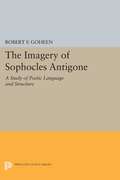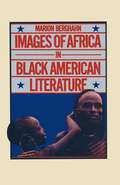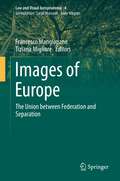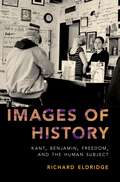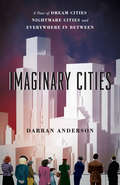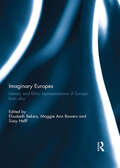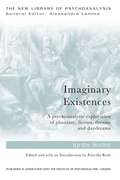- Table View
- List View
Imagery and Text: A Dual Coding Theory of Reading and Writing
by Mark Sadoski Allan PaivioImagery and Text, Second Edition extends the first edition’s unified theory of cognition in literacy from the perspective of Dual Coding Theory (DCT), one of the most influential and empirically sound theories of cognition ever developed. This theory provides a comprehensive, systematic account of all major aspects of literacy including decoding, comprehension, and response in reading and composing in writing. The Second Edition updates DCT as a scientific theory, a cognitive theory, an embodied theory, and a constructivist theory of literacy. New content includes a detailed account of the decoding process and its integral connection to comprehension, a new program of research on DCT in composing text, a review of neuroscientific support, and increased attention to multimedia literacy, socio-cultural influences, and recent educational applications. More than any other theory, DCT explains how both verbal and nonverbal cognition are woven together through all aspects of literacy. Written in concise chapters with illustrative examples, Imagery and Text is approachable for both students and advanced scholars in the field of literacy.
Imagery of Sophocles Antigone
by Robert Francis GoheenA systematic investigation of a Greek text, employing the techniques of the "new criticism." The book is a major contribution to the study of Sophocles and of Greek drama.Originally published in 1951.The Princeton Legacy Library uses the latest print-on-demand technology to again make available previously out-of-print books from the distinguished backlist of Princeton University Press. These editions preserve the original texts of these important books while presenting them in durable paperback and hardcover editions. The goal of the Princeton Legacy Library is to vastly increase access to the rich scholarly heritage found in the thousands of books published by Princeton University Press since its founding in 1905.
Images and Contexts: The Historiography of Science and Modernity in India
by Dhruv RainaThis volume situates the historiography of science in India within a social theory of science. It deals with paradigm shift within science studies, the move away from a West-centric theory of science, and future trends and possibilities. The book takes up several strands from the corpus of writing over the past 150 years and places them within the context of their times. It analyses ideas about the interplay between centre and periphery, internal and external accounts of science, creative tension between scientism and romanticism, model of colonial science and its relationship with the emergence of national science, and the distortions of nationalist historiography.
Images in Mobile Communication: New Content, New Uses, New Perspectives
by Corinne Martin Thilo Von PapeImages of Europe: The Union between Federation and Separation (Law and Visual Jurisprudence #4)
by Francesco Mangiapane Tiziana MiglioreThis book deals with the fundamental semantics of images of Europe, which consist of valences, mirror beliefs and affectivities. This is why it relaunches the importance of the European discourse in its symbolic dimension. As such, it explores the many images of Europe, or rather the many images through which European discourse is actually constituted in daily life, in search of their enunciative responsibility in today’s world for determining the current “State of the Union”. The identity of the European continent is based on a millenary tension between universalism and particularism: images of Europe have in fact been alternately inspired, over the centuries, by a model of homogeneity – Roman and Carolingian imperial disposition – on the one hand, and by a model of fragmentation – a Europe of city-states, municipalities, regions and small fatherlands – on the other. In the European Union, a political and economic organism, this issue has recently been amplified to the point that it has reentered public debate, and political parties that are only recognizable for being Europeanists or anti-Europeanists are now ubiquitous. In this regard, one major bone of contention is how to portray the quintessential aspects of the European territory, which are either interpreted as “thresholds” to be overcome in the name of a model of United Europe – “integral totality” – or are instead regarded as insurmountable obstacles for a Europe that is irreparably and perhaps, according to anti-Europeanists, fortunately fragmented – “partitive totality”. Further, this is to be done without excluding the possibility of contradictory and complementary solutions to these binary visions. In this context the book analyzes various texts in order to obtain a more precise picture of the clash, reveal its semiotic forms, and by doing so, identify a way out of the crisis.
Images of History: Kant, Benjamin, Freedom, and the Human Subject
by Richard EldridgeDeveloping work in the theories of action and explanation, Eldridge argues that moral and political philosophers require accounts of what is historically possible, while historians require rough philosophical understandings of ideals that merit reasonable endorsement. Both Immanuel Kant and Walter Benjamin recognize this fact. Each sees a special place for religious consciousness and critical practice in the articulation and revision of ideals that are to have cultural effect, but they differ sharply in the forms of religious-philosophical understanding, cultural criticism, and political practice that they favor. Kant defends a liberal, reformist, Protestant stance, emphasizing the importance of liberty, individual rights, and democratic institutions. His fullest picture of movement toward a moral culture appears in Religion within the Bounds of Mere Reason, where he describes conjecturally the emergence of an ethical commonwealth. Benjamin defends a politics of improvisatory alertness and consciousness-raising that is suspicious of progress and liberal reform. He practices a form of modernist, materialist criticism that is strongly rooted in his encounters with Kant, Hölderlin, and Goethe. His fullest, finished picture of this critical practice appears in One-Way Street, where he traces the continuing force of unsatisfied desires. By drawing on both Kant and Benjamin, Eldridge hopes to avoid both moralism (standing on sharply specified normative commitments at all costs) and waywardness (rejecting all settled commitments). And in doing so, he seeks to make better sense of the commitment-forming, commitment-revising, anxious, reflective and sometimes grownup acculturated human subjects we are.
Images of History: Kant, Benjamin, Freedom, and the Human Subject
by Richard EldridgeDeveloping work in the theories of action and explanation, Eldridge argues that moral and political philosophers require accounts of what is historically possible, while historians require rough philosophical understandings of ideals that merit reasonable endorsement. Both Immanuel Kant and Walter Benjamin recognize this fact. Each sees a special place for religious consciousness and critical practice in the articulation and revision of ideals that are to have cultural effect, but they differ sharply in the forms of religious-philosophical understanding, cultural criticism, and political practice that they favor. Kant defends a liberal, reformist, Protestant stance, emphasizing the importance of liberty, individual rights, and democratic institutions. His fullest picture of movement toward a moral culture appears in Religion within the Bounds of Mere Reason, where he describes conjecturally the emergence of an ethical commonwealth. Benjamin defends a politics of improvisatory alertness and consciousness-raising that is suspicious of progress and liberal reform. He practices a form of modernist, materialist criticism that is strongly rooted in his encounters with Kant, Hölderlin, and Goethe. His fullest, finished picture of this critical practice appears in One-Way Street, where he traces the continuing force of unsatisfied desires. By drawing on both Kant and Benjamin, Eldridge hopes to avoid both moralism (standing on sharply specified normative commitments at all costs) and waywardness (rejecting all settled commitments). And in doing so, he seeks to make better sense of the commitment-forming, commitment-revising, anxious, reflective and sometimes grownup acculturated human subjects we are.
Imaginary Cities: A Tour of Dream Cities, Nightmare Cities, and Everywhere in Between
by Darran AndersonFor as long as humans have gathered in cities, those cities have had their shining—or shadowy—counterparts. Imaginary cities, potential cities, future cities, perfect cities. It is as if the city itself, its inescapable gritty reality and elbow-to-elbow nature, demands we call into being some alternative, yearned-for better place. This book is about those cities. It’s neither a history of grand plans nor a literary exploration of the utopian impulse, but rather something different, hybrid, idiosyncratic. It’s a magpie’s book, full of characters and incidents and ideas drawn from cities real and imagined around the globe and throughout history. Thomas More’s allegorical island shares space with Soviet mega-planning; Marco Polo links up with James Joyce’s meticulously imagined Dublin; the medieval land of Cockaigne meets the hopeful future of Star Trek. With Darran Anderson as our guide, we find common themes and recurring dreams, tied to the seemingly ineluctable problems of our actual cities, of poverty and exclusion and waste and destruction. And that’s where Imaginary Cities becomes more than a mere—if ecstatically entertaining—intellectual exercise: for, as Anderson says, “If a city can be imagined into being, it can be re-imagined.” Every architect, philosopher, artist, writer, planner, or citizen who dreams up an imaginary city offers lessons for our real ones; harnessing those flights of hopeful fancy can help us improve the streets where we live. Though it shares DNA with books as disparate as Calvino’s Invisible Cities and Jane Jacobs’s Death and Life of Great American Cities, there’s no other book quite like Imaginary Cities. After reading it, you’ll walk the streets of your city—real or imagined—with fresh eyes.
Imaginary Cities: A Tour of Dream Cities, Nightmare Cities, and Everywhere in Between
by Darran AndersonFor as long as humans have gathered in cities, those cities have had their shining—or shadowy—counterparts. Imaginary cities, potential cities, future cities, perfect cities. It is as if the city itself, its inescapable gritty reality and elbow-to-elbow nature, demands we call into being some alternative, yearned-for better place. This book is about those cities. It’s neither a history of grand plans nor a literary exploration of the utopian impulse, but rather something different, hybrid, idiosyncratic. It’s a magpie’s book, full of characters and incidents and ideas drawn from cities real and imagined around the globe and throughout history. Thomas More’s allegorical island shares space with Soviet mega-planning; Marco Polo links up with James Joyce’s meticulously imagined Dublin; the medieval land of Cockaigne meets the hopeful future of Star Trek. With Darran Anderson as our guide, we find common themes and recurring dreams, tied to the seemingly ineluctable problems of our actual cities, of poverty and exclusion and waste and destruction. And that’s where Imaginary Cities becomes more than a mere—if ecstatically entertaining—intellectual exercise: for, as Anderson says, “If a city can be imagined into being, it can be re-imagined.” Every architect, philosopher, artist, writer, planner, or citizen who dreams up an imaginary city offers lessons for our real ones; harnessing those flights of hopeful fancy can help us improve the streets where we live. Though it shares DNA with books as disparate as Calvino’s Invisible Cities and Jane Jacobs’s Death and Life of Great American Cities, there’s no other book quite like Imaginary Cities. After reading it, you’ll walk the streets of your city—real or imagined—with fresh eyes.
Imaginary Cities: A Tour of Dream Cities, Nightmare Cities, and Everywhere in Between
by Darran AndersonFor as long as humans have gathered in cities, those cities have had their shining—or shadowy—counterparts. Imaginary cities, potential cities, future cities, perfect cities. It is as if the city itself, its inescapable gritty reality and elbow-to-elbow nature, demands we call into being some alternative, yearned-for better place. This book is about those cities. It’s neither a history of grand plans nor a literary exploration of the utopian impulse, but rather something different, hybrid, idiosyncratic. It’s a magpie’s book, full of characters and incidents and ideas drawn from cities real and imagined around the globe and throughout history. Thomas More’s allegorical island shares space with Soviet mega-planning; Marco Polo links up with James Joyce’s meticulously imagined Dublin; the medieval land of Cockaigne meets the hopeful future of Star Trek. With Darran Anderson as our guide, we find common themes and recurring dreams, tied to the seemingly ineluctable problems of our actual cities, of poverty and exclusion and waste and destruction. And that’s where Imaginary Cities becomes more than a mere—if ecstatically entertaining—intellectual exercise: for, as Anderson says, “If a city can be imagined into being, it can be re-imagined.” Every architect, philosopher, artist, writer, planner, or citizen who dreams up an imaginary city offers lessons for our real ones; harnessing those flights of hopeful fancy can help us improve the streets where we live. Though it shares DNA with books as disparate as Calvino’s Invisible Cities and Jane Jacobs’s Death and Life of Great American Cities, there’s no other book quite like Imaginary Cities. After reading it, you’ll walk the streets of your city—real or imagined—with fresh eyes.
Imaginary Cities: A Tour of Dream Cities, Nightmare Cities, and Everywhere in Between
by Darran AndersonFor as long as humans have gathered in cities, those cities have had their shining—or shadowy—counterparts. Imaginary cities, potential cities, future cities, perfect cities. It is as if the city itself, its inescapable gritty reality and elbow-to-elbow nature, demands we call into being some alternative, yearned-for better place. This book is about those cities. It’s neither a history of grand plans nor a literary exploration of the utopian impulse, but rather something different, hybrid, idiosyncratic. It’s a magpie’s book, full of characters and incidents and ideas drawn from cities real and imagined around the globe and throughout history. Thomas More’s allegorical island shares space with Soviet mega-planning; Marco Polo links up with James Joyce’s meticulously imagined Dublin; the medieval land of Cockaigne meets the hopeful future of Star Trek. With Darran Anderson as our guide, we find common themes and recurring dreams, tied to the seemingly ineluctable problems of our actual cities, of poverty and exclusion and waste and destruction. And that’s where Imaginary Cities becomes more than a mere—if ecstatically entertaining—intellectual exercise: for, as Anderson says, “If a city can be imagined into being, it can be re-imagined.” Every architect, philosopher, artist, writer, planner, or citizen who dreams up an imaginary city offers lessons for our real ones; harnessing those flights of hopeful fancy can help us improve the streets where we live. Though it shares DNA with books as disparate as Calvino’s Invisible Cities and Jane Jacobs’s Death and Life of Great American Cities, there’s no other book quite like Imaginary Cities. After reading it, you’ll walk the streets of your city—real or imagined—with fresh eyes.
Imaginary Citizens: Child Readers and the Limits of American Independence, 1640–1868
by Courtney Weikle-MillsFrom the colonial period to the end of the Civil War, children’s books taught young Americans how to be good citizens and gave them the freedom, autonomy, and possibility to imagine themselves as such, despite the actual limitations of the law concerning child citizenship. Imaginary Citizens argues that the origin and evolution of the concept of citizenship in the United States centrally involved struggles over the meaning and boundaries of childhood. Children were thought of as more than witnesses to American history and governance—they were representatives of "the people" in general. Early on, the parent-child relationship was used as an analogy for the relationship between England and America, and later, the president was equated to a father and the people to his children. There was a backlash, however. In order to contest the patriarchal idea that all individuals owed childlike submission to their rulers, Americans looked to new theories of human development that limited political responsibility to those with a mature ability to reason. Yet Americans also based their concept of citizenship on the idea that all people are free and accountable at every age. Courtney Weikle-Mills discusses such characters as Goody Two-Shoes, Ichabod Crane, and Tom Sawyer in terms of how they reflect these conflicting ideals.
Imaginary Citizens: Child Readers and the Limits of American Independence, 1640–1868
by Courtney Weikle-MillsFrom the colonial period to the end of the Civil War, children’s books taught young Americans how to be good citizens and gave them the freedom, autonomy, and possibility to imagine themselves as such, despite the actual limitations of the law concerning child citizenship. Imaginary Citizens argues that the origin and evolution of the concept of citizenship in the United States centrally involved struggles over the meaning and boundaries of childhood. Children were thought of as more than witnesses to American history and governance—they were representatives of "the people" in general. Early on, the parent-child relationship was used as an analogy for the relationship between England and America, and later, the president was equated to a father and the people to his children. There was a backlash, however. In order to contest the patriarchal idea that all individuals owed childlike submission to their rulers, Americans looked to new theories of human development that limited political responsibility to those with a mature ability to reason. Yet Americans also based their concept of citizenship on the idea that all people are free and accountable at every age. Courtney Weikle-Mills discusses such characters as Goody Two-Shoes, Ichabod Crane, and Tom Sawyer in terms of how they reflect these conflicting ideals.
An Imaginary England: Nation, Landscape and Literature, 1840–1920
by Roger EbbatsonIn his highly theorised and original book, Roger Ebbatson traces the emergence of conceptions of England and Englishness from 1840 to 1920. His study concentrates on poetry and fiction by authors such as Alfred Lord Tennyson, Richard Jefferies, Thomas Hardy, Q, Rupert Brooke and D.H. Lawrence, reading them as a body of work through which a series of problematic English identities are imaginatively constructed. Of particular concern is the way literary landscapes serve as signs not only of identity but also of difference. Ebbatson demonstrates how a sense of cultural rootedness is contested during the period by the experiences of those on the societal margins, whether sexual, national, social or racial, resulting in a feeling of homelessness even in the most self-consciously 'English' texts. In the face of gradual imperial and industrial decline, Ebbatson argues, foreign and colonial cultures played a crucial role in transforming Englishness from a stable body of values and experiences into a much more ambiguous concept in continuous conflict with factors on the geographical or psychological 'periphery'.
An Imaginary England: Nation, Landscape and Literature, 1840–1920
by Roger EbbatsonIn his highly theorised and original book, Roger Ebbatson traces the emergence of conceptions of England and Englishness from 1840 to 1920. His study concentrates on poetry and fiction by authors such as Alfred Lord Tennyson, Richard Jefferies, Thomas Hardy, Q, Rupert Brooke and D.H. Lawrence, reading them as a body of work through which a series of problematic English identities are imaginatively constructed. Of particular concern is the way literary landscapes serve as signs not only of identity but also of difference. Ebbatson demonstrates how a sense of cultural rootedness is contested during the period by the experiences of those on the societal margins, whether sexual, national, social or racial, resulting in a feeling of homelessness even in the most self-consciously 'English' texts. In the face of gradual imperial and industrial decline, Ebbatson argues, foreign and colonial cultures played a crucial role in transforming Englishness from a stable body of values and experiences into a much more ambiguous concept in continuous conflict with factors on the geographical or psychological 'periphery'.
Imaginary Europes: Literary and filmic representations of Europe from afar
by Elisabeth Bekers Maggie Ann Bowers Sissy HelffThe 20th century has witnessed crucial changes in our perceptions of Europe. Two World Wars and many regional conflicts, the end of empires and of the Eastern Bloc, the creation and expansion of the European Union, and the continuous reshaping of Europe’s population through emigration, immigration, and globalization have led to a proliferation of images of Europe within the continent and beyond. While Eurocentrism governs current public debates in Europe, this book takes a special interest in literary and cinematographic imaginings of Europe that are produced from more distant, decentred, or peripheral vantage points and across differences of political power, ideological or ethnic affinity, cultural currency, linguistic practice, and geographical location. The contributions to this book demonstrate how these particular imaginings of Europe, often without first-hand experience of the continent, do not simply hold up a mirror to Europe, but dare to conceive of new perspectives and constellations for Europe that call for a shifting of critical positions. In so doing, the artistic visions from afar confirm the significance of cultural imagination in (re)conceptualizing the past, present, and future of Europe. This book was originally published as a special issue of the Journal of Postcolonial Writing.
Imaginary Europes: Literary and filmic representations of Europe from afar
by Elisabeth Bekers, Maggie Ann Bowers and Sissy HelffThe 20th century has witnessed crucial changes in our perceptions of Europe. Two World Wars and many regional conflicts, the end of empires and of the Eastern Bloc, the creation and expansion of the European Union, and the continuous reshaping of Europe’s population through emigration, immigration, and globalization have led to a proliferation of images of Europe within the continent and beyond. While Eurocentrism governs current public debates in Europe, this book takes a special interest in literary and cinematographic imaginings of Europe that are produced from more distant, decentred, or peripheral vantage points and across differences of political power, ideological or ethnic affinity, cultural currency, linguistic practice, and geographical location. The contributions to this book demonstrate how these particular imaginings of Europe, often without first-hand experience of the continent, do not simply hold up a mirror to Europe, but dare to conceive of new perspectives and constellations for Europe that call for a shifting of critical positions. In so doing, the artistic visions from afar confirm the significance of cultural imagination in (re)conceptualizing the past, present, and future of Europe. This book was originally published as a special issue of the Journal of Postcolonial Writing.
Imaginary Existences: A psychoanalytic exploration of phantasy, fiction, dreams and daydreams (The New Library of Psychoanalysis)
by Ignes SodreImaginary Existences: A psychoanalytic exploration of phantasy, fiction, dreams and daydreams interweaves scholarly psychoanalytic knowledge and extensive clinical experience with insights derived from close readings of great literature in a uniquely imaginative and creative manner, convincingly demonstrating how these two ways of thinking – psychoanalysis and literary criticism – organically relate to each other. This is simultaneously a psychoanalytic book and a book about literature, illuminating the imaginative possibilities present within both the psychoanalytic encounter and the act of reading fiction. Scholarly and well researched, the psychoanalytic ideas presented have their basis in the work of Freud and Klein and some of their followers; the extensive and innovative writing about the great authors in Western literature is equally scholarly and lucent. Here, Ignês Sodré explores creativity itself and, specifically, the impediments to creative thinking: defences, mostly narcissistic, against dependency, guilt and loss, and the mis-use of imagination to deny reality. In her studies of the characters created by authors such as George Eliot, Cervantes, Flaubert, Thomas Mann, Proust and Shakespeare, Sodré examines the way great writers create characters who mis-use their imagination, twisting reality into romantic daydreams or sado-masochistic enactments, which petrify experience and freeze the fluidity of thought. Her clinical studies continue and expand this theme, broadening the field and lending verification and weight to the arguments. These two poles of Sodré’s thinking – psychoanalysis and literature – interact seamlessly in Imaginary Existences; the two disciplines work together, each an intimate part of a learned exploration of the human condition: our desires, our fears and our delusions. This convergence pays tribute to the great depth of the fictional work being studied and to the psychological validity of the psychoanalytic ideas. This book will be of interest to psychoanalysts, psychologists, psychotherapists, literary critics, and those interested in literature and literary criticism.
Imaginary Existences: A psychoanalytic exploration of phantasy, fiction, dreams and daydreams (The New Library of Psychoanalysis)
by Ignes SodreImaginary Existences: A psychoanalytic exploration of phantasy, fiction, dreams and daydreams interweaves scholarly psychoanalytic knowledge and extensive clinical experience with insights derived from close readings of great literature in a uniquely imaginative and creative manner, convincingly demonstrating how these two ways of thinking – psychoanalysis and literary criticism – organically relate to each other. This is simultaneously a psychoanalytic book and a book about literature, illuminating the imaginative possibilities present within both the psychoanalytic encounter and the act of reading fiction. Scholarly and well researched, the psychoanalytic ideas presented have their basis in the work of Freud and Klein and some of their followers; the extensive and innovative writing about the great authors in Western literature is equally scholarly and lucent. Here, Ignês Sodré explores creativity itself and, specifically, the impediments to creative thinking: defences, mostly narcissistic, against dependency, guilt and loss, and the mis-use of imagination to deny reality. In her studies of the characters created by authors such as George Eliot, Cervantes, Flaubert, Thomas Mann, Proust and Shakespeare, Sodré examines the way great writers create characters who mis-use their imagination, twisting reality into romantic daydreams or sado-masochistic enactments, which petrify experience and freeze the fluidity of thought. Her clinical studies continue and expand this theme, broadening the field and lending verification and weight to the arguments. These two poles of Sodré’s thinking – psychoanalysis and literature – interact seamlessly in Imaginary Existences; the two disciplines work together, each an intimate part of a learned exploration of the human condition: our desires, our fears and our delusions. This convergence pays tribute to the great depth of the fictional work being studied and to the psychological validity of the psychoanalytic ideas. This book will be of interest to psychoanalysts, psychologists, psychotherapists, literary critics, and those interested in literature and literary criticism.
The Imaginary Library: An Essay on Literature and Society
by Alvin B. KernanIn this speculative treatment of literature as a social institution, Alvin B. Kernan explores the inability of contemporary writers and critics to maintain a literary vision in a society that denies their values and methods.Originally published in 1982.The Princeton Legacy Library uses the latest print-on-demand technology to again make available previously out-of-print books from the distinguished backlist of Princeton University Press. These editions preserve the original texts of these important books while presenting them in durable paperback and hardcover editions. The goal of the Princeton Legacy Library is to vastly increase access to the rich scholarly heritage found in the thousands of books published by Princeton University Press since its founding in 1905.
Imaginary Maps
by Mahasweta DeviImaginary Maps presents three stories from noted Bengali writer Mahasweta Devi in conjunction with readings of these tales by famed cultural and literary critic, Gayatri Chakravorty Spivak. Weaving history, myth and current political realities, these stories explore troubling motifs in contemporary Indian life through the figures and narratives of indigenous tribes in India. At once delicate and violent, Devi's stories map the experiences of the "tribals" and tribal life under decolonization. In "The Hunt," "Douloti the Bountiful" and the deftly wrought allegory of tribal agony "Pterodactyl, Pirtha, and Puran Sahay," Ms. Devi links the specific fate of tribals in India to that of marginalized peoples everywhere. Gayatri Spivak's readings of these stories connect the necessary "power lines" within them, not only between local and international structures of power (patriarchy, nationalisms, late capitalism), but also to the university.
Imaginary Maps
by Mahasweta DeviImaginary Maps presents three stories from noted Bengali writer Mahasweta Devi in conjunction with readings of these tales by famed cultural and literary critic, Gayatri Chakravorty Spivak. Weaving history, myth and current political realities, these stories explore troubling motifs in contemporary Indian life through the figures and narratives of indigenous tribes in India. At once delicate and violent, Devi's stories map the experiences of the "tribals" and tribal life under decolonization. In "The Hunt," "Douloti the Bountiful" and the deftly wrought allegory of tribal agony "Pterodactyl, Pirtha, and Puran Sahay," Ms. Devi links the specific fate of tribals in India to that of marginalized peoples everywhere. Gayatri Spivak's readings of these stories connect the necessary "power lines" within them, not only between local and international structures of power (patriarchy, nationalisms, late capitalism), but also to the university.
Imaginary Worlds: Invitation to an Argument (Palgrave Studies in Literary Anthropology)
by Wayne FifeIn this work, the author contends that we should create a comparative framework for the study of imaginary worlds in the social sciences. Making use of extended examples from both science fiction and fantasy fiction, as well as the living movement of steampunk, the reader is invited to an argument about how best to define imaginary worlds and approach them as social locations for qualitative research. It is suggested in this volume that increasing economic and existential forms of alienation fuel the contemporary surge of participation in imaginary worlds (from gaming worlds to young adult novels) and impel a search for more humane forms of social and cultural organization. Suggestions are made about the usefulness of imaginary worlds to social scientists as places for both testing out theoretical formulations and as tools for teaching in our classrooms.

